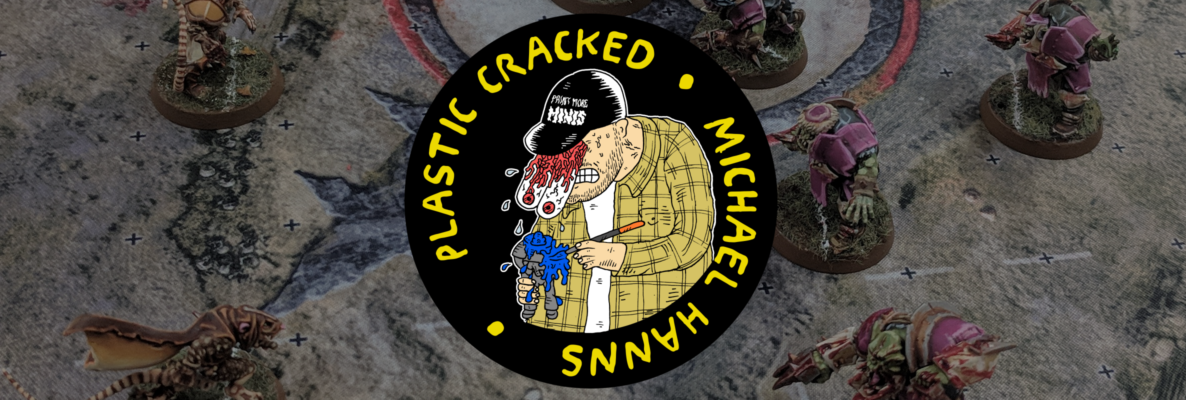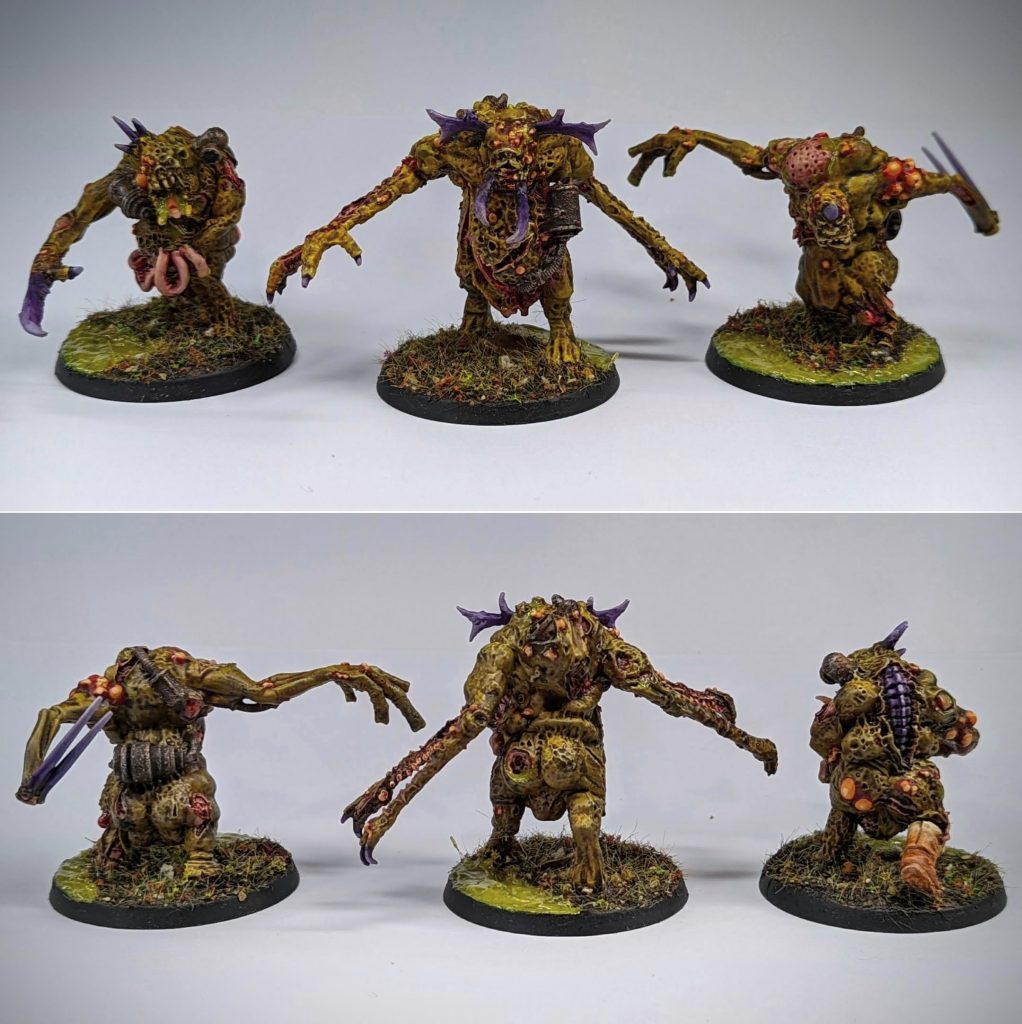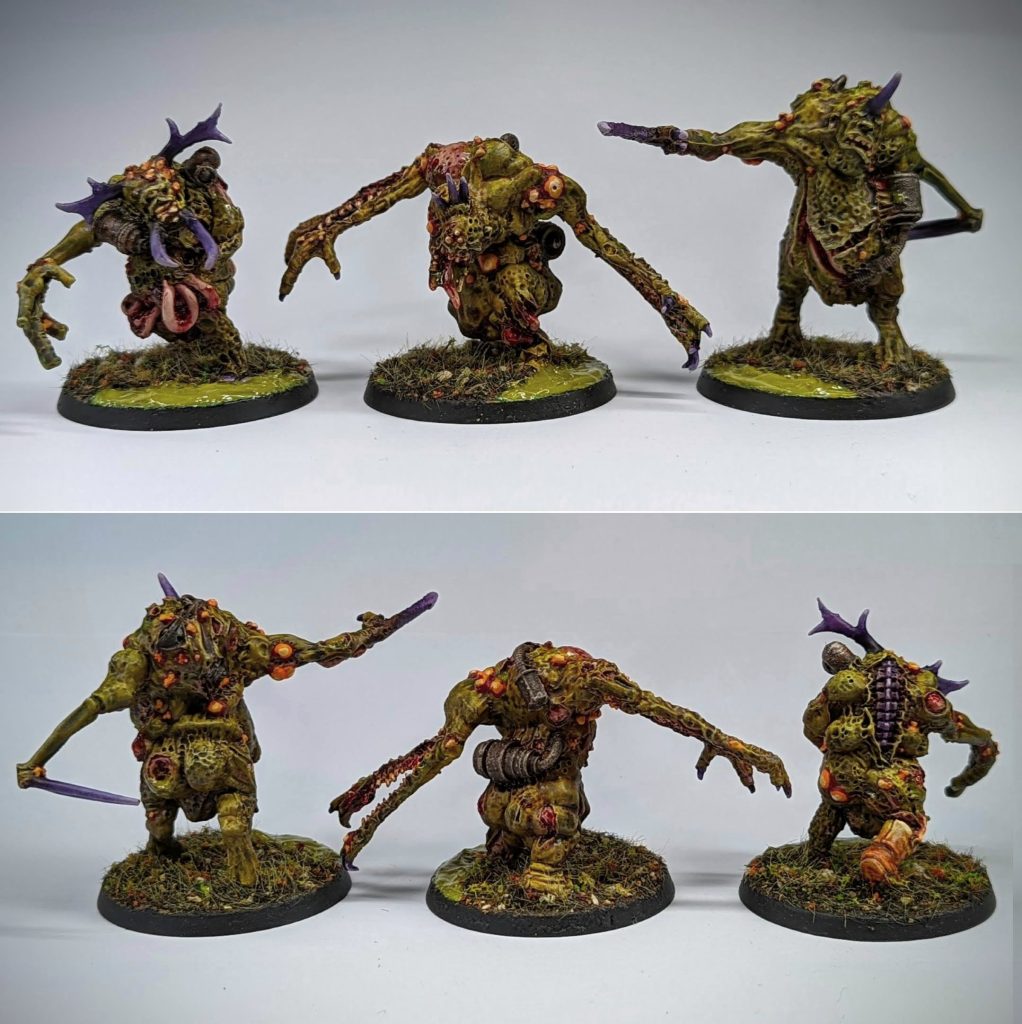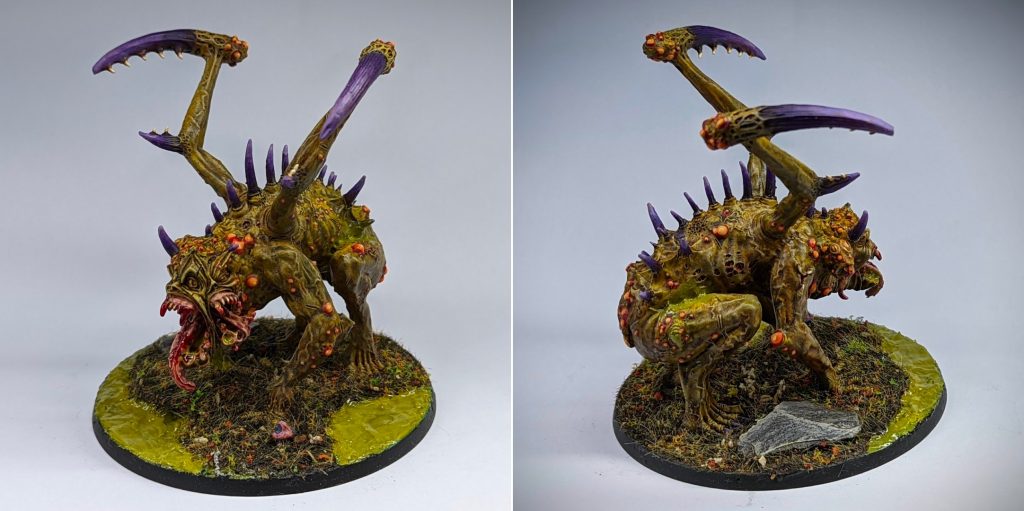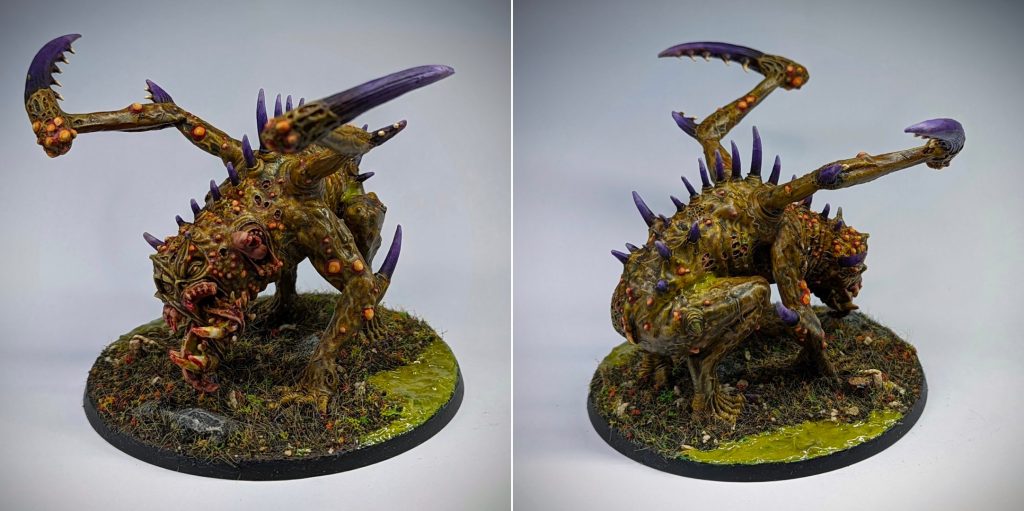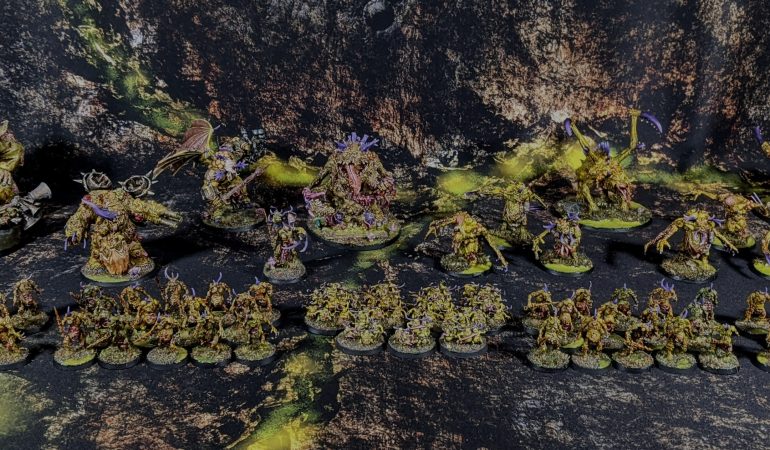
Back in April 2019, ForgeWorld finally released a long overdue publication – the infamous Book 8, Malevolence for their Horus Heresy game. I had planned to wait until December to pick one up for Christmas, only for the hardback copy to go out of print forever sometime in November. This took a lot of people – myself included – by surprise, particularly when you consider that Book 1 Betrayal was still available in Hardback despite releasing nearly a decade prior. Malevolence quickly became some kind of mythical white whale for Heresy players, with hardback copies of Malevolence fetching upwards of £400 on eBay.
This is a terrible shame, because Book 8 Malevolence contains one of the most compelling and interesting army lists that Games Workshop have published since the 3.5th edition Chaos Space Marines codex – the Daemons of the Ruinstorm. It’s a fully customisable and highly thematic set of rules for running your own special brand of Chaos Daemons in the Horus Heresy, allowing you to assign all manner of wildly varied daemonic traits to a list of blank slate profiles. When I finally got a look at the list for myself, I couldn’t resist making a few additions and turning my languishing Maggotkin of Nurgle army for Age of Sigmar into a Creeping Scourge Daemons army for Horus Heresy. I wrote about this process back in 2019, and you can read about it here.
Still, as cool as it was to get a new gaming army off the ground for next to no effort, I couldn’t ever really bring myself to take it to any events. While it’s satisfying to make something out of pretty much nothing, something just didn’t really sit right with me about the army. The plastic Plague Drones and Beasts didn’t actually conform to Daemon Brutes base sizes in the book (literally the only hard guideline that the book asks of you), and the aesthetic of the army was all over the place. The plastic Beasts of Nurgle in particular have a really goofy and cartoonish design that doesn’t look right alongside the grim aesthetic of Cor’Bax or my flying ForgeWorld Deamon Prince Shrike. I wanted something more consistent and cohesive.
I’ve been playing the long game with this one, biding my time with an arsenal of eBay Saved Searches. Eventually, I was able to score a few additional out of production ForgeWorld miniatures that would take this army from a cheap repurposing to a whole new force in and of itself. Finally, I could strip away the Drones and the Beasts and replace them with something altogether nastier.
The first of the new additions were a couple units of Daemon Brutes. ForgeWorld makes some pretty serviceable ‘generic’ Daemon Brutes miniatures that would probably do in a pinch after little Nurglification1, but once upon a time they made a far superior unit for this role – the Plague Ogryns. Originally released alongside a load of Traitor Guard stuff for their Siege of Vraks supplement back in the day, these guys are the perfect choice for Daemon Brutes – not only do their base sizes match up, but they perfectly look the part; they’re daemonic and they’re brutal.
The Plague Ogryns come in a set of three monopose sculpts, so I had to get a little creative to avoid obvious duplicates – mixing and matching the various bodies, heads and arms. Some of these pairings worked a little better than others, but to be honest it doesn’t really matter if you leave massive gaps on a Nurgle Daemon miniature – these are by some measure the easiest kind of miniature to sculpt missing detail onto. Gaps can be filled and don’t really need to be smoothed out the way armour panels do, while any janky or imperfect looking detail can be obscured with additional pustules. I make these from a little blob of green stuff or – my personal preference – drops from a bottle of ‘pearl effect’ finger nail polish. This stuff comes in a dropper bottle, dries nice and firm and leaves a perfect smooth blobby finish.
By the time I was finished, I had 6 completely unique Creeping Scourge Daemon Brutes. These fit the style and aesthetic of the army perfectly, bridging the gap between my gnarly resin Daemon Princes and Lords and the plastic Plaguebearer minis. In fact, they look so much like giant Plaguebearers that I think they’d make perfect 54mm daemons for Inquisitor. I could definitely see myself using these as NPC threats or even another warband in a pinch.
With these new Plague Ogryns replacing my Drones and Beasts as my Elites slot, the army was looking a whole lot more consistent aesthetically. Great, but something else was still bothering me – I had absolutely nothing in my Heavy Support slots. Enter the Giant Chaos Spawn.
This was another discontinued ForgeWorld kit – one that I’ve always liked but never really had a legitimate use for until now2. These were the perfect size for Greater Daemon Beasts, a kind of ‘vehicle sized’ Daemon that come in small units of 1-3 models. Kind of a similar sort of role to a Tyranid Carnifex. I managed to blag myself two of these for my army.
Once again, I wasn’t super keen on the idea of having two identical beasts in a unit, so I did a little converting in order to distinguish the pair. The first of these was pretty much built as intended, although I added one of those horrible tongues-with-mouths from the Plague Drones kit inside one of the mouths and a few large pustules for a little extra Nurgle flair. For the second, I decided to saw the head off and remove the neck mouth entirely, reposing the head to be looking a little more up and to the left, then filled the empty space on the right side of it’s neck with a green stuff and a spare head from the Plague Drone kit. Once again, a little more extra Nurgle flavour while the addition of the head helped minimise how much green stuff was on show. I also reversed the direction of the pincers on one of the beasts, giving it a slightly more streamlined profile than the other.
Happy with my simple but effective conversions, I set about painting all 8 of the miniatures in one big batch. One of the great things about Daemons in particular is that you can really get a lot out of these miniatures using very quick and dirty painting techniques. The sky’s the limit if you want to really push the zenithal and macro contrast on the flesh, but if you’re just looking to get some cool minis on the table, you can achieve this pretty quickly. Nurgle Daemons are an army that I have been collecting for a very long time now, so I don’t have a lot of motivation to really push myself with these minis – I’m way more concerned with keeping them consistent with the rest of the army.
My process is pretty simple. First, I prime the miniatures using Krylon Camoflague Khaki paint out of a rattle can. Once this is dry, I hit the models with some white spray paint (or airbrush paint) from above and from the front. This brightens up the miniature, bringing focus to the top of the miniature and the face while leaving shadows on the underside and in deep recesses. Once this has dried, I then hit the miniature with an all over coat of Yellow Ink – this brings the two base colours together a little and gives the daemons a bit of a jaundiced look. From here, I apply two successive washes to the model with Athonian Camoshade and Reikland Fleshshade, shading the flesh and giving it a greenish/fleshy tone. The end result is this olive green, jaundiced mess of sickly looking flesh – perfect for the followers of Nurgle.
The next step is picking out the spines, bones and horns in purple. For this, I start with a basecoat of Heavy Purple, wash it with Druchii Violet, then apply anywhere between four and eight successive receding layers of Heavy Purple, adding a little Elfic Flesh into the mix each time. I usually try and keep these layers fairly thin and transparent – particularly towards the end – and this creates a decent looking gradient that pops on the tabletop and contrasts nicely with the olive, jaundiced flesh. Best of all, you don’t need to be especially careful or tidy with where you put each layer, as long as you apply a little less each layer. It’s quick and effective and provides a nice colourful contrast against the olive flesh.
Next up, I pick out any of the flesh and entrails. This is usually basecoated Squid Pink, then layered with Rosy Flesh, highlighted in some places with a little Elfic Flesh mixed into Rosy Flesh and finally washed with Reikland Fleshshade mixed with a little Seraphim Sepia. This creates a brownish, pinkish flesh and is perfect for any hanging entrails, tongues or gums. I find using two tonally different colours for the layers on the flesh (pastel pink and orangey flesh) followed by a unifying wash of Fleshshade is a really quick and effective way to get some depth in the colour of the entrails over just a couple of layers.
Finally, the last big step is the pustules. This can be tedious, but it can also be kind of soothing. The worst step is the first – picking out Heavy Red. This takes the longest as it requires painting around the edges, as well as actively finding all the bumps in the flesh for the first time. After this, I quickly dot the pustles with smaller, receding layers of Blood Red, Orange Fire and Filthy Brown. I batch these layers across as many minis as possible so I don’t have to worry too much about how much paint is on my brush. By the time you’ve dotted all the pustules with Blood Red, the first mini will be ready for the Orange Fire layer and so on.
And that’s kind of.. it, really. There’s a few more details here and there – teeth are painted in Elfic Flesh, washed with Seraphim Sepia and layered with Elfic Flesh again. Metallics on the Ogryns were painted Gun Metal, coated in Typhus Corrosion then drybrushed with Ryza Rust and Shining Silver. Once everything is finished, I spray them all in Matt Varnish and – once this is dry – slap a little Blood for the Blood God and Nurgle’s Rot around the mouth, teeth, expoed flesh and entrails. Easy.
Even basing is dead simple – a little texture paint goes down, leaving a little recession towards an edge or two which is painted Mutation Green. Once this dries, I take some Matt Varnish and brush it all over the texture paint, then dip the whole thing into a flock mixture made of Serious Play Rotting Marshland and a little Gale Force 9 Autumn Flock Blend – the Autumn Blend has a bit of a fungal spores look about it when mixed in with a forest scatter. Next, I paint over the Mutation Green with Nurgle’s Rot and once that dries, I put a layer of Vallejo Water Texture over the top to give it a little extra thickness and body. Then we’re done!
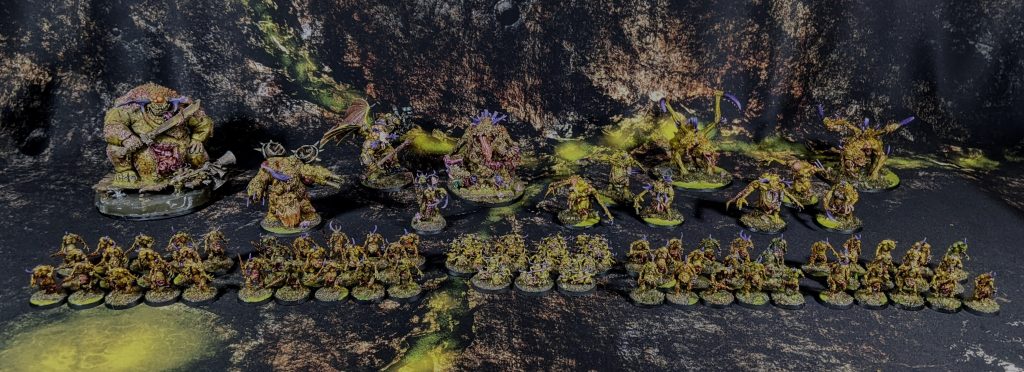
Of course, once I finished my Brutes and Greater Daemon Beasts, I couldn’t help but take an updated Family Photo of the Creeping Scourge, could I? I’m really pleased to see how much more cohesive everything looks, although I kind of regret using my plague planet mat as a backdrop for these minis – they actually kind of blend a little too well into it. Whoops. I think the army looks great together, and I can now realistically field it as anywhere from 3000 to 3500 points (as of Malevolence), depending on whether I use my Exalted Great Unclean One as a Greater Daemon HQ or Daemon Behemoth Lord of War. The grim and grimy aesthetic of the ForgeWorld models definitely suit The Horus Heresy a lot better than the plastic Beasts of Nurgle used to – I just hope they don’t end up completely butchering the Daemons of the Ruinstorm list for Heresy 2.0!
Speaking of Heresy 2.0, I have a whole lot of new stuff coming up in the pipeline for my Space Wolves legion – from simple modifications to keep my Grey Slayers legal under the new rules to whole new units like Seekers, Destroyers, Deathsworn and Dreadnoughts. All of that is.. still happening, but as is tradition here, something entirely different has come entirely out of left field. Could it be my first wholly new army project of 2022? Keep your eyes peeled for news on this new development very soon.
Until then, thanks for reading and happy wargaming!
1 What do you mean ‘Nurglification’ is not a real word?
2 Honestly one of the best features of these miniature-agnostic army lists like Daemons of the Ruinstorm or Cults and Militia.
